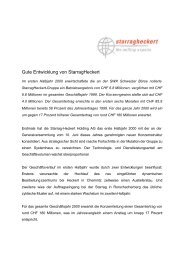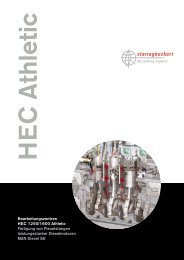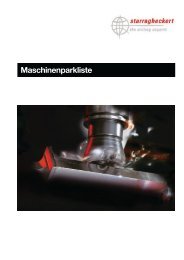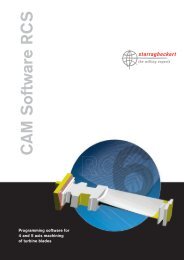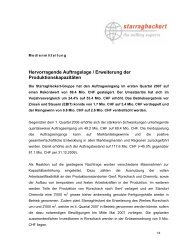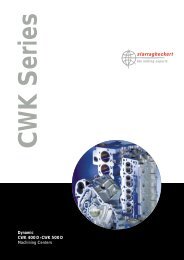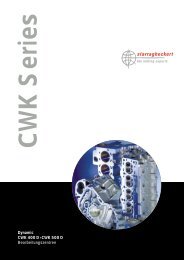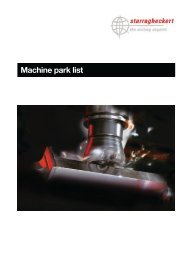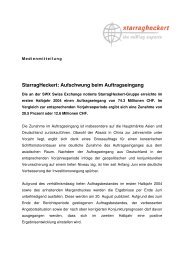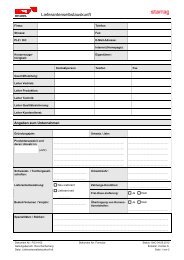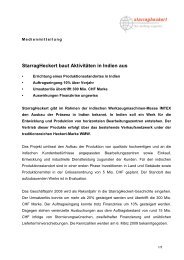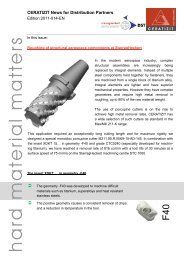Create successful ePaper yourself
Turn your PDF publications into a flip-book with our unique Google optimized e-Paper software.
70 Consolidated financial statements<br />
––<br />
the taxable profits of the group. For tax (esp.<br />
withholding tax) on future dividend payments on<br />
retained earnings, provisions are only set up if<br />
such dividend payments are probable. Provisions<br />
for deferred income tax are calculated by applying<br />
the liability method on the temporary differences<br />
between the carrying values and tax values of assets<br />
and liabilities. Tax relief on tax losses carried<br />
forward is only recognized to the extent that it is<br />
probable that sufficient future taxable profit will<br />
be available to be set off against the tax loss carry<br />
forward.<br />
Cash and cash equivalents<br />
Cash and cash equivalents include cash and bank<br />
balances as well as sight and deposit money with<br />
an original term of less than 3 months. These are<br />
valued at market value.<br />
Receivables<br />
Receivables are carried at their nominal value less<br />
impairment allowance, which approximates the<br />
market value. The impairment allowance is determined<br />
on the basis of due dates and recognizable<br />
credit risks. Receivables include receivables from<br />
percentage of completion valued contracts after<br />
deduction of received payments.<br />
Inventories<br />
Raw materials and trade goods are carried at<br />
average purchase costs, manufactured products<br />
at average manufacturing costs. Discounts are<br />
recognized as purchase cost reductions. If the<br />
realizable net value is lower, valuation adjustments<br />
are made accordingly. Manufacturing costs<br />
include the direct costs of materials used, labour<br />
and operating costs as well as an appropriate<br />
portion of related overhead costs. Obsolete and<br />
slow-moving items are adequately provided for.<br />
Tangible fixed assets<br />
Tangible fixed assets are carried at historical costs<br />
less appropriately accumulated depreciation.<br />
Depreciation is calculated using the straight line<br />
method for the estimated useful lives of: buildings<br />
20 to 50 years (considering an adequate residual<br />
value), technical equipment and machines 4 to<br />
12 years, IT hardware and communication 3 to 8<br />
years. Land is not depreciated.<br />
All gains and losses on disposals of tangible fixed<br />
assets are recognized in the income statement.<br />
Assets of low value are charged directly to operating<br />
expenses.<br />
Intangible assets<br />
Goodwill resulting from the acquisition of a<br />
company is reported in intangible assets. It is<br />
assumed that goodwill has an unlimited useful life<br />
and thus is not amortized but reassessed at least<br />
once a year (impairment test). Impairment tests<br />
are based on the current three-year business<br />
plans, which take into consideration both past<br />
developments and expectations regarding future<br />
market and business developments. The discount<br />
rates applied are pre-tax interest rates and they<br />
reflect market- and country-specific risks.<br />
If an impairment test indicates that the carrying<br />
value of an asset exceeds the value in use, an<br />
impairment loss covering the excess of the carrying<br />
amount over the value in use will be recorded.<br />
Other intangible assets are carried at historical<br />
cost less accumulated amortization. Using the<br />
straight line method, amortization of intangible assets<br />
is effected for the estimated useful life, i.e.,<br />
technology assets 5 to 20 years, brands 5 to 20<br />
years, customer relationships 2 to 20 years and IT<br />
software 3 to 8 years.<br />
Provisions<br />
Provisions are made if a present obligation resulting<br />
from a past event exists, the use of resources<br />
for the settlement of such an obligation is probable<br />
and a reliable estimation of the amount of the<br />
obligation can be made. The amount of provisions<br />
depends on the expected use of funds needed to<br />
cover the obligation.<br />
Pension benefits<br />
The pension benefit situation of Starrag Group



